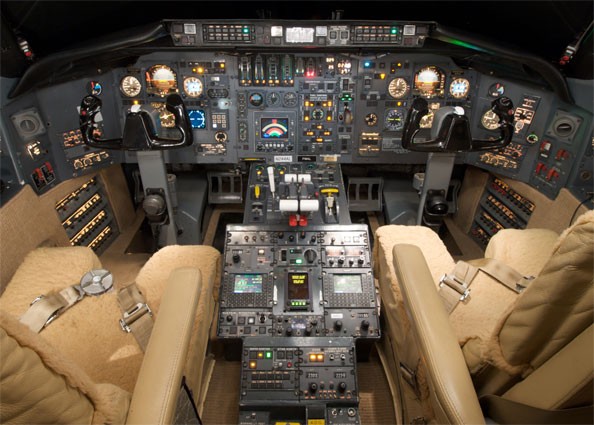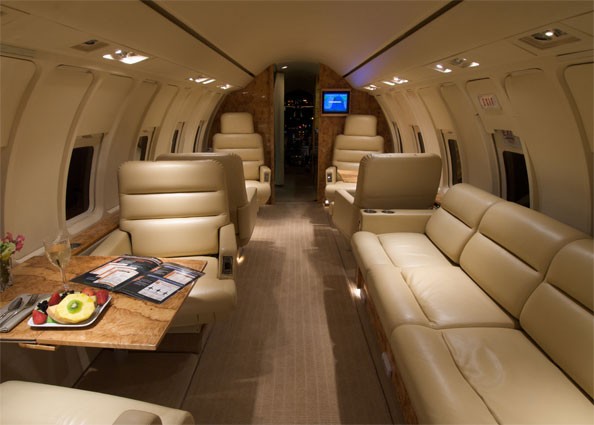


Aircraft Description
Background/History
The Challenger 600 began as Bill Lear’s LearStar 600 intercontinental tri-jet design. The rights to the project were purchased by Canadair Ltd in 1976, and the CL-600 went through a difficult period of development as it evolved into the twin turbofan Challenger. Numerous costly redesigns pushed the timetable off schedule and necessitated a financial bailout of Canadair by the Canadian government. By the time of its introduction in 1980, the Challenger 600, equipped with troublesome Lycoming ALF 502 powerplants, had ballooned far beyond its targeted weight, and its 2,600 nm IFR range fell short of the 3,900 miles projected in the original plan. It nonetheless broke new ground as a business jet with true wide-body comfort for passengers. First flight of the Challenger 600 was accomplished in November 1978 and FAA certification was granted in November 1980. A pair of underfloor fuel tanks were offered to CL-600 owners as a free retrofit to increase range. The Challenger 601 which followed featured General Electric CF34 turbofans and aerodynamic refinements to give the transoceanic range originally envisioned for the Challenger line. When the Challenger 600 was succeeded by the 601 series in 1983, a total of 85 Challenger 600s had been delivered.
Power
The Challenger 600 is powered by a pair of Lycoming ALF 502-L-2C fanjets rated at 7,500 lbs. of thrust each. Engine inspection interval is 6,000 hours.
Avionics
The Challenger 600 was introduced before EFIS was commonly available, and so the 600’s panel was fitted with analog electromechanical ADI’s and HSI’s, the Sperry SPZ-600 analog flight guidance system and SPZ-650 autopilot, an analog air data computer, Primus 400 weather radar, and Collins Pro Line 1 comm/nav/ident radios. The Global Navigation GNS 500 VLF/Omega nav system, Delco Carousel INS, and HF transceiver options were commonly installed.
Design Features
The Challenger 600 is a twin turbofan, medium range, wide-body business jet configured as a cantilever low swept-wing monoplane. It has retractable tricycle landing gear with two wheels on each unit and a trailing link main gear design. A large airstair door is located on the forward port side of the fuselage.The Challenger features a large fuselage cross-section, resulting in a spacious and comfortable cabin. Additional fuselage fuel tanks and winglets were offered as a free retrofit by Canadair in order to increase the range.
Accomodations
In contrast to his early Lear Jet designs, whose tight cabins were predicated on a philosphy of short leg lengths and high speed at minimal cost, Bill Lear drew his LearStar 600 with a spacious cabin in which passengers could bask in comfort for transcontinental stage lengths. The eight foot, two inch fuselage cross section of the Challenger 600 which descended from Lear’s design allows for a very roomy interior. It is commonly outfitted for 8 to 12 passengers plus galley and full-size lavatory, although as many as 18 passengers can be accommodated in a high-density seating arrangement.
| General | Challenger 600, CL-600-1A11 | |||
|---|---|---|---|---|
| Category | Jet < 20,000 lbs. | |||
| Years Aircraft Manufactured | 1981 – 1983 | |||
| Serial Number Range | 1001 – 1085 | |||
| Retail High Price | $3,895,000.00 / 3,056,406.50€ | |||
| Retail Low Price | $695,000.00 / 545,366.50€ | |||
| Characteristics | Challenger 600, CL-600-1A11 | |||
| Seating | 2 + 9/19 | |||
| Wing Loading | 91.3 | |||
| Power Loading | 2.7 | |||
| Noise(EPNdB): Takeoff/Sideline/Approach | 84.4/91.6 | |||
| External Dimensions (ft) | Challenger 600, CL-600-1A11 | |||
| External Length | 68.4 | |||
| External Height | 20.7 | |||
| External Span | 64.3 | |||
| Internal Dimensions (ft) | Challenger 600, CL-600-1A11 | |||
| Internal Length (Overall/Net Height) | 28.25 | |||
| Internal Height | 6.1 | |||
| Internal Width (Max/Floor) | 8.17 | |||
| Baggage | Challenger 600, CL-600-1A11 | |||
| External: Cu.Ft./Lb. | 115/425 | |||
| External: Cu.Ft./Lb. | N/A | |||
| Power | Challenger 600, CL-600-1A11 | |||
| Engines | 2 Lyc ALF 502-L-2C | |||
| Output (lbs ea.)/Flat Rating | 7,500 | |||
| Inspection Interval | 4000t | |||
| Data based on latest manufactured year | ||||



